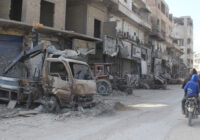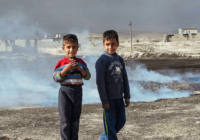The extent to which the Islamic State has re-established itself in a country where it was supposedly defeated is testament to its resilience and to the appeal of its extremist ideology.
The narrative is an appealing one. The Islamic State (IS or ISIS) was cornered and down to defending a single village, Baghouz, in southeastern Syria, near the Iraqi border. A vast caliphate that once stretched across Syria and Iraq is utterly vanquished. Barghouz was the “last stand” for IS, and once it fell, victory was proclaimed.
Much of the reporting in the media subscribed, to a lesser or greater extent, to that narrative. On March 8, NBC provided footage of what it called “a glimpse of what is left of the ISIS caliphate.” Days earlier, CNN argued that IS was “reduced to a last sliver of land,” and Barghouz, this “last stand, last bastion, will go down in a torrent of fire and blood.”
That such a narrative track is widely off the mark helps to obscure an unpalatable truth. The Islamic State is anything but defeated. As the Washington-based Institute for the Study of War (ISW) notes, IS is well on its way to re-establishing sanctuary in Iraq. A comprehensive report released on March 7 details nine regions where IS either has durable support or is militarily entrenched, from Iraqi Kurdistan to the Baghdad Belts regions that encircle the capital city, to the Jazeera Desert in the west and the Hamrin Mountains running from Diyala Province north of Baghdad, through to Kirkuk Province on the border of Iraqi Kurdistan.
The extent to which the Islamic State has re-established itself in a country where it was supposedly defeated is testament to its resilience and to the appeal of an extremist ideology that has, counter to wishful thinking, only been reinforced by battlefield losses. Nor ought one discount the shrewd and strategic military tactics Abu Bakr al-Baghdadi, the self-proclaimed caliph, and his advisers have brought to bear in a war they see as being without end.
Testament to Resilience
The Hamrin Mountains serve as good evidence. The city of Hawija, which sits adjacent to the mountain range, was the last major urban center to fall to Iraqi forces in September 2017, two months after the liberation of Mosul. The city had been held for three years by IS and before that was, for several years, a hotbed of Sunni insurgency against the Shia-dominated central government. ISW describes it as “a historical stronghold for ISIS and its predecessor al Qaeda in Iraq (AQI) with a sympathetic population of Sunni Arabs.”
When IS abandoned the city to coalition forces, it moved into the mountains, which provide both security from airstrikes and support from the locals. It also left behind sleeper cells to be activated at the appropriate time. Tensions between Iraqi Kurdish forces on the one hand, and the Iraqi Security Forces (ISF) and the Shia Popular Mobilization Forces (PMF) militia on the other, created what the ISW calls “security gaps” that IS was able to further exploit. Efforts to dislodge IS from its mountain sanctuary have thus far failed.
Another case in point is Mosul, Iraq’s second largest city, much of which was destroyed in the battle to free it from the caliphate. Many of the city’s Sunni Arab population that was displaced by the war has declined to return, discouraged by IEDs left behind by the jihadists, by the lack of reconstruction progress and by ongoing insecurity. As ISW notes “ISIS established a network of sleeper cells throughout Mosul after its recapture by the U.S. Anti-ISIS Coalition in July 2017.”
It was members of these cells that were responsible for several vehicle-borne improvised explosive device (VBIED) attacks in Mosul, the most recent occurring on February 28 this year. Such attacks underscore how little security the central government is providing for returnees. The corruption and incompetency that have marred efforts at reconstruction of the city have provided further propaganda wins for IS. The displaced Sunni population also faces hostility from the PMF encamped around Mosul. Many feel they have little choice but to remain in impoverished refugee camps, angry, fearful and unhappy. It is a situation that plays into the hands of IS.
In the south of the country, Anbar Province saw brutal fighting in the liberation of the cities of Fallujah and Ramadi in June and July 2016. It was hailed at the time as a significant victory. The victory, however, has been undercut by a growing IS presence. As the ISW report notes: “The (Iraqi army) discovered sophisticated tunnel networks entering Fallujah from the direction of Amariyat al-Fallujah in January 2019. ISIS likely used the tunnels to infiltrate cells into the city. Security forces later arrested more than 180 individuals connected to ISIS in Fallujah in February 2019.”
Add to that the expansion of support zones linking the Baghdad Belts to Diyala and Anbar provinces, and the large support zone that exists in the western Jazeera Desert bordering on Syria, and what emerges is the picture of a shadow caliphate, one that has significant military prowess unencumbered by the exigencies of running a formal state. Hit-and-run guerrilla raids, the assassination of bureaucrats and tribal leaders allied to the central government, the destruction of government facilities, ongoing suicide and VBIED attacks leading to a constant state of insecurity are all the hallmark of this shadow caliphate.
Continuing Deadlock
What makes the situation even more favorable for IS is the continuing deadlock in forming a national government in Baghdad, six months after an election that had already suffered from a very low voter turnout. The impasse between two Shia blocs over ministerial appointments means that the reconstruction work, which is so crucial to preventing the country from sliding back into an anarchic state of war, is scarcely being undertaken. Meanwhile, endemic corruption cripples what little is being done.
The situation could hardly be riper for a second IS jihad. The shadow caliphate can argue that takfiri Iran is an occupying force “enslaving” Sunni Iraqis. The Iranians arm and support the Shia militias and already have a significant military presence in Iraq, one that the Islamic State will be determined to confront. For its part, Iran will not hesitate to defend Baghdad, as it did in the past, should IS threaten to take the capital.
A confrontation between Iranian forces and the Islamic State in Iraq is a scenario that US Secretary of State Mike Pompeo and National Security Adviser John Bolton might well find useful. An Iran dragged into a bloody local war at a time when the United States is ramping up hard sanctions is a weakened Iran, one where regime change could become less of a pipe dream and more of a reality.
As Trump’s America strives to replace the ayatollahs while simultaneously trying to disengage from the war against the Islamic State, talk of last stands is wildly premature. It dramatically underestimates both the broader geopolitical narrative and the military prowess of an enemy driven by an intractable, brutal and uncompromising ideology.
*[This article was originally published by Gulf State Analytics.]
The views expressed in this article are the author’s own and do not necessarily reflect Fair Observer’s editorial policy.
Support Fair Observer
We rely on your support for our independence, diversity and quality.
For more than 10 years, Fair Observer has been free, fair and independent. No billionaire owns us, no advertisers control us. We are a reader-supported nonprofit. Unlike many other publications, we keep our content free for readers regardless of where they live or whether they can afford to pay. We have no paywalls and no ads.
In the post-truth era of fake news, echo chambers and filter bubbles, we publish a plurality of perspectives from around the world. Anyone can publish with us, but everyone goes through a rigorous editorial process. So, you get fact-checked, well-reasoned content instead of noise.
We publish 2,500+ voices from 90+ countries. We also conduct education and training programs
on subjects ranging from digital media and journalism to writing and critical thinking. This
doesn’t come cheap. Servers, editors, trainers and web developers cost
money.
Please consider supporting us on a regular basis as a recurring donor or a
sustaining member.
Will you support FO’s journalism?
We rely on your support for our independence, diversity and quality.







